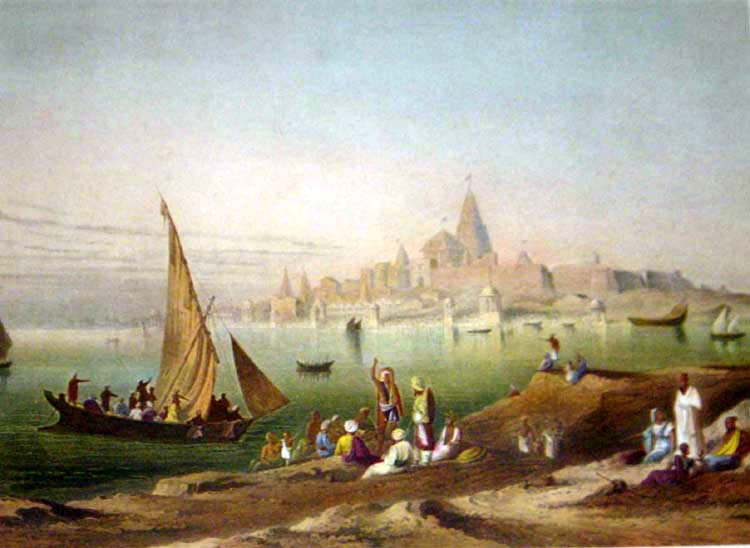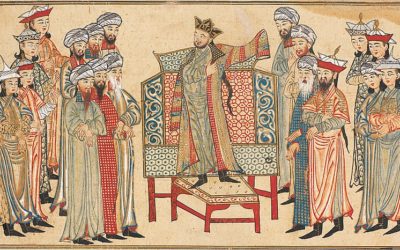In April 1983 Dr. S R Rao, accidentally lay his hands on the monumental historical city of Dwarka. Along with his team, this emeritus scientist at the marine archaeology unit of the National Institute of Oceanography, Goa and Indian representative of The International Committee on Underwater Cultural Heritage (ICUCH) made this discovery while repairing the famous temple of Dwarakadeesh at Dwaraka. Between 1983 to 1990 Dr. Rao, armed with the moderate grant of Rs. 80,000 for a 2-year project of Marine Archaeological Studies in India,conducted 12 expeditions and identified two underwater settlements. One was located near present-day Dwarka and the other in the nearby island of Bet Dwarka, near the Gulf of Khambhat, Gujarat, on the western coast of India.
The Oldest City in the World
The archeologists established that Dwarka existed 32,000 to 9,000 years ago and was the most advanced city of Lord Krishna. V S Gopalkrishnan, in his article, cites video documentaries of Graham Hancock, a British writer and journalist, who mentioned that the original Dwarka city is datable to 9,500 BC. This establishes Dwarka as older than cities in the Egyptian and Mesopotamian civilizations by more than 5,000 years. He affirms that Dwarka therefore becomes notable as the oldest city in the world. In other words, Indian and indeed World history need to be rewritten!
An Ancient Tsunami Swallowed Dwaraka
This beautiful city now remains etched in our memories through picturesque videos and images on the internet and in books. The scientists believe that a huge tsunami may have swallowed this golden city. The melting of the ice caps about 8,000-10,000 years ago caused sea waters to rise nearly 400 feet, which swallowed the old Dwarka city. Dwarka has behemoth relevance in modern society and would be an immense source of advanced education and knowledge to scientists and technologists.
A Big Jolt to Hindu Mythology Sceptics
This discovery brought to life the undeniable truth that Dwarka, lucidly mentioned in ancient Hindu scriptures, indeed existed. Mahabharata (Mausala Parva), the Dvaraka Mahatmya of the Skanda Purana, the Ghata Jataka, Vishnu Purana and Harivamsa all refer to this sacred city.
For those sceptics who debunk Hindu mythology, Dr S R Rao responds in his book The Lost City of Dwarka, published in 1999, chronicling his archaeological findings based on facts and evidences found. “The discovery is an important landmark in the history of India. It has set to rest the doubts expressed by historians about the historicity of Mahabharata and the very existence of Dwarka city.”
A Science and Technology Marvel
The invincible truth is that Dwarka was way ahead of its time in all areas of urbanization and civilization – be it military technology, use of atomic power, specialised air attacks, aviation and spacecrafts, avante garde town planning, architecture, highly futuristic maritime technology and ports, sophisticated metallurgy and textile industry, and above all, highly progressive trade and international business. Dwaraka was the epitome of technology and science. The human race took multiple centuries to re-learn and assimilate research to reach some level of advancement to that of Krishna’s state-of-the-art Dwarka. .
The Gateway to Heaven
The modern city of Dwarka which means ‘Gateway to Heaven’ in Sanskrit, is regarded as the most prominent Char Dham (the four sacred pilgrimage sites of Hinduism). It is also one of the seven most ancient religious sites in the country, namely Ayodhya, Mathura, Haridwar, Banaras, Kanchi, Ujjain and Dwarka.
In Hindu mythology, Dwarka was a city where Krishna, the eighth avatar of Vishnu, and his clan Yadavas once lived. In one account of the history, Krishna was brought to the coast of Saurashtra in north-western India by Garuda (the sacred vehicle of Vishnu), where Krishna founded the city of Dwaraka. In another account, Krishna invoked Vishwakarma, the deity of construction, when he decided to build his new city. Samudradev, gave Krishna twelve yojanas(773 square km/298.5 square miles) of land. With this land, Vishwakarma used his divine powers to build the legendary city of Dwaraka.
Fabulous Town Planning
The ancient Dwaraka layout can be a quintessential piece of art and instruction for modern city planners and civil engineers. The city, also referred to as Kususthali, was divided into six sectors – contained residential and commercial areas, wide roads, plazas, palaces (700,000 that were made of gold, silver and precious stones), as well as numerous public facilities, including beautiful gardens and lakes. A hall called the sudharma sabha(Meeting of True Religion) was the place where public meetings were held. As the city was surrounded by water, it was connected to the mainland via bridges and a port.
Industries and Harbor of an Advanced Port City
The discovery highlighted how Dwarka was an urban center with certain specialized industries such as boat-building, shell-working, pearl-diving and metalworking too. The existence of massive blocks with L-shaped joints to withstand battering by waves and currents, proves that Dwarka engineers had the necessary skills to build port installations in the sea or in the intertidal zone. The Dwaraka harbour provides the earliest evidence of modifying natural rock to serve the needs of a harbour.
During the course of the explorations in 1988, “It was found that the buildings were raised on boulder foundation – as is now done by modern engineers for buildings in reclaimed areas of Bombay. This ancient technique confirms the references in the Epic and Puranas to reclamation of land from the sea for building.”
All Good Things Come to an End
“The Bhagavata Purana (11.30.5) mentions:
ete ghora mahotpata dvarvatyam yama-ketavah,
muhurtam api na stheyam atra no yadu-pungavah.
The literal translation of which is, “This calamity itself has become a symbol of death. The Yadavas should not stay here even a moment longer.”
An account in the Mahabharata mentions the submergence of Dwarka thus: “The sea surrounding Dwarka, which had been beating against the shores, suddenly broke the boundary that was imposed on it. The sea rushed and coursed through the streets of the beautiful city. It covered up everything! Even as they all looked on in horror, Arjuna saw the beautiful buildings becoming submerged one by one. He took a last look at the mansion of Krishna. It was soon covered by the sea. In a matter of a few moments, it was all over. The sea had now become as placid as a lake. There was no trace of the beautiful city that had been the favorite haunt of all the Pandavas. Dwaraka became just a name; just a memory.”
Conclusion
We sadly lost several years of advancement when the rising sea swallowed Dwarka. Words from poet John Milton’s poem Paradise Lost aptly fits Krishna’s Dwarka – “These are sweeter than all the delicious fruits he could have grown in Paradise before he fell.”
References:
- http://www.hinduwisdom.info/Dwaraka.htm
- http://creative.sulekha.com/ancient-indian-history-needs-rewriting-dwarka-is-the-oldest-city-on-earth_498610_blog : Ancient Indian History Needs Rewriting: Dwaraka is the Oldest City on Earth, V.S.Gopalakrishnan
- https://kalyan97.wordpress.com/2007/10/12/1057/. Notes on Rama Setu and Dwarka by S R Rao
- https://www.youtube.com/watch?v=HBQO7gOMLuw : Discovered Underwater in Gulf of Khambhat) , Documentary run by History.com, where main reporters were Graham Hancock, David Childress, Author – technology of Gods, Michael Cremo, Editor , Forbidden Archaeology, Published on Aug 25, 2015, Lost Worlds : Lost City of Dvarka : S R Rao
- http://www.ancient-origins.net/ancient-places-asia/dwarka-home-krishna-gateway-heaven-and-underwater-city-004227 : Dwarka: The Home of Krishna is a Gateway to Heaven and an Underwater City, 18 October, 2015 – 00:49dhwty
- http://www.messagetoeagle.com/sophisticated-vimanas-over-dwarka-pre-harappan-city-that-could-rewrite-the-history-of-the-world/ : Home »Ancient Civilizations & Places » Sophisticated Vimanas Over Dwarka – Pre-Harappan City That Could Rewrite The History Of The World
- A TLC series segment chronicling the discovery of what was thought to be the Hindu God Krishna’s underwater city, Dwarka. Written, Produced and Directed by Virginia Williams. (2001) *Best Documentary, TV Asia Awards 2002



0 Comments